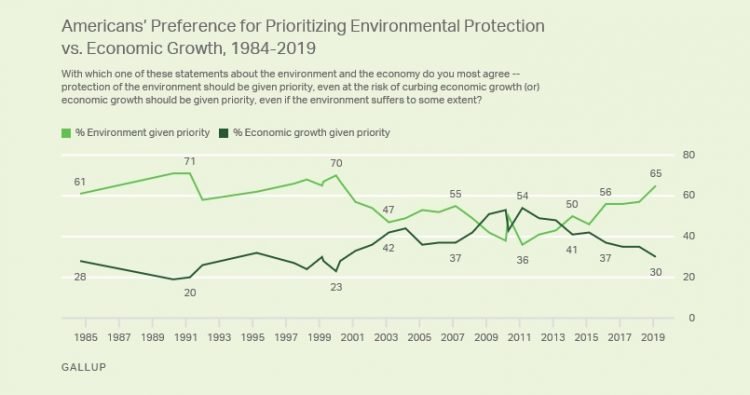By the widest margin since 2000, more Americans believe environmental protection should take precedence over economic growth when the two goals conflict.
Sixty-five percent in the non-partisan Gallup poll now choose the environment, up eight percentage points from a year ago, while 30% choose the economy.
Adults aged 18 to 34 are more likely than those 35 and older to give precedence to environmental protection over economic growth.
However, the sharpest differences are by political party.
Eight in 10 Democrats (82%) and 71% of independents prioritize environmental protection, versus 35% of Republicans.
On the flip side, the majority of Republicans (60%) say economic growth should be considered first, versus 24% of independents and 13% of Democrats.
Since 1984, Gallup has asked whether “protection of the environment should be given priority, even at the risk of curbing economic growth” or “economic growth should be given priority, even if the environment suffers to some extent.”
A preference for environmental protection has typically led economic growth on this question by a significant margin.
However, between 2009 and 2013 as the economy struggled to emerge from the recession, more Americans prioritized the economy over the environment, with a brief exception in May 2010 after the Gulf of Mexico oil spill.
Environmental protection is not a hallmark of the Trump administration.
The Environmental Protection Agency’s new administrator says unsafe drinking water is “probably the biggest environmental threat” the world faces.
Andrew Wheeler told CBS News climate change is “an important issue” but most of the threats it poses are “50 to 75 years out” and it’s “unreasonable” for the 2020 Democratic candidates to focus so much on it.
Climate scientists see the necessity for broad and immediate action to address global warming.
The United Nations says “now is the defining moment to do something about it.
Perhaps the decision that set the tone for the Trump administration’s approach to the environment is when he moved to withdraw from the Paris Climate Agreement in June of 2017.
To many, it signaled less U.S. leadership in international climate change agreements.
The Clean Power Plan was one of the Obama’s signature environmental policies.
It required the energy sector to cut carbon emissions by 32 percent by 2030, but in October 2017 it was rolled back by Trump’s EPA.
Among the reasons cited were unfair burdens on the power sector and a “war on coal.”
Then the EPA loosened regulations on toxic air pollution.
Under the Affordable Clean Energy rule issued in August 2018, states were given more power over regulating emissions.
In states like California, that means regulations would likely be stricter, whereas states that produce fossil fuels are likely to weaken regulations.
The following month, the EPA announced they would relax rules around releasing methane flares, inspecting equipment, and repairing leaks.
Under the Obama administration’s fuel economy targets, cars made after 2012 would, on average, have to get 54 miles per gallon by 2025.
In August 2018, the Trump Department of Transportation and EPA capped that target at 34 miles per gallon by 2021.
The decision created legal conflict with states like California that have higher emission caps. (Read more about speed bumps in the way of super-efficient cars.)
Water.
In August 2017, Trump also revoked an Obama-era executive order that required federally funded projects to factor rising sea levels into construction.
The latest results are from Gallup’s 2019 Environment survey, conducted March 1-10.

